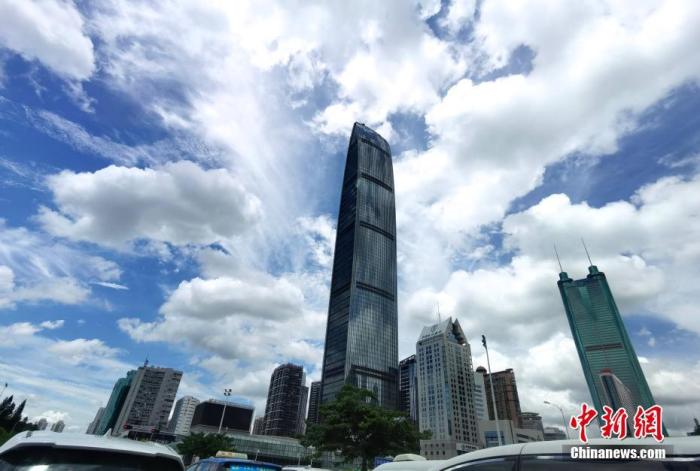(Special Zone for 40 Years) Shenzhen Realizes Benign Economic and Tax Interaction
China News Service, Beijing, August 26 (Reporter Zhao Jianhua) Shenzhen Special Economic Zone is celebrating its 40th anniversary. Expert analysis shows that in the past 40 years, Shenzhen, which has created miracles, has achieved a positive interaction between economic development and government taxation.
The picture shows one of Shenzhen's landmark buildings-Kingkey 100 Building. China News Agency reporter Chen Wenshe
"Time is money, and efficiency is life." 40 years ago, after Yuan Geng, the commander-in-chief of the construction headquarters of the Shekou Industrial Zone, proposed that "4 cents for each additional truckload of soil and rock transported", the Shenzhen Shekou Industrial Zone widely adopted the overproduction award system. , Which greatly aroused the enthusiasm of workers for production, and the factory workshop was fully equipped. According to data on the turnover tax sources of key industries in Shenzhen, from 1980 to 1991, the proportion of light industries such as clothing, shoes and hats, and daily necessities in the turnover tax of the production link rose rapidly, from 37.3% to 91.2%.
40 years later, Shenzhen’s economic pillar has long since transformed from a processing industry of “three to one supplement” to four major industries including finance, logistics, culture, and high-tech. Among them, the largest pole is high-tech.
The picture shows the landmark building "Chunsun" in Nanshan District. China News Agency reporter Chen Wenshe
Among the many high-tech enterprises, Shenzhen Huada Beidou Technology Co., Ltd. is the first Beidou GNSS satellite navigation and positioning chip design company in Shenzhen, and it is also the strong "core" support behind the Beidou satellite navigation system. Peng Xiaojun, deputy general manager of the company, said that the growth of "China Chip" is inseparable from the guidance of national policies and the support of preferential taxes and fees. As of August 2020, enterprises have enjoyed 1.88 million yuan of value-added tax credit (RMB, the same below), and R&D expenses in 2019 will be deducted up to 5.55 million yuan. Just a few days ago, the staff of the tax bureau came to the door to explain in detail the latest "Several Policies to Promote the High-quality Development of the Integrated Circuit Industry and Software Industry in the New Era".
The government's policy support has injected a booster for Shenzhen Huada Beidou Technology Co., Ltd. and other companies.
The picture shows the Happy Coast of Overseas Chinese Town by the Shenzhen Bay. China News Agency reporter Chen Wenshe
In the past 40 years, Shenzhen has created 8 Fortune 500 companies including Ping An, Huawei, Zhengwei International, Evergrande Group, China Merchants Bank, Tencent, Vanke, and Shenzhen Investment Control. Nearly 300 Fortune 500 companies have invested in Shenzhen. According to Tang Jiqiang, a professor at Southwestern University of Finance and Economics, Shenzhen has always let the market play a full role in resource allocation. In addition to the Fortune Global 500, Shenzhen has also cultivated dozens of unicorn companies such as DJI and BGI, and more than 17,000 high-tech companies.
While actively playing the role of the market, Shenzhen has also better played the role of the government. Take taxation as an example. In 1982, Shenzhen introduced a policy. The “three foreign-funded enterprises” in the special zone can enjoy a low tax rate of 15%, two exemptions, three halves, three exemptions, four halves, and other preferential policies. The means of production are exempt from consolidated industrial and commercial tax. The inclination of the policy gave the original special zone a special position, so that the development of Shenzhen has "excellent" conditions and "extremely fast" speed.
The picture shows the night view of Shenzhen Civic Center. China News Agency reporter Chen Wenshe
After the SAR policy was gradually unified with the whole country, Shenzhen did not stand still. Tang Jiqiang said that in terms of taxation, Shenzhen has made full use of national policies and actively innovated collection and management methods. In view of the 15% corporate income tax policy for high-tech enterprises, the Shenzhen tax authorities have widely publicized the enterprises to do a solid job in the certification of high-tech enterprises, so that as many high-tech enterprises as possible can enjoy the national support policies at the beginning Growth and expansion have created more space.
In the benign interaction between economy and taxation, Shenzhen has rapidly jumped into a modern metropolis, with its GDP rising from 196 million yuan in 1979 to 2.69 trillion yuan in 2019. Shenzhen's local fiscal revenue has also increased from 17 million yuan in 1979 to 377.321 billion yuan in 2019. If the central government revenue is included, Shenzhen’s tax output per square kilometer reaches 410 million yuan, ranking first among large and medium-sized cities in the country.
According to Li Xuhong, director of the Institute of Fiscal and Taxation Policy and Application of Beijing National Accounting Institute, Shenzhen has a high degree of marketization and rapid economic growth has created more tax revenue, giving the government more resources to improve public service levels. The government and the market coordinate better in the allocation of resources, so that market players can accumulate more and seek better development. Its innovation, convenience, and the coordinated relationship between the market and the government are all worth promoting nationwide.
Li Xuhong, who has studied Shenzhen for many years, said that the talents who flock to Shenzhen from all over the country want to seek a better development environment. They see forward-looking that by creating a good business environment to meet the needs of market players, the government can obtain more tax revenue and provide better public services for enterprises and residents. (Finish)

